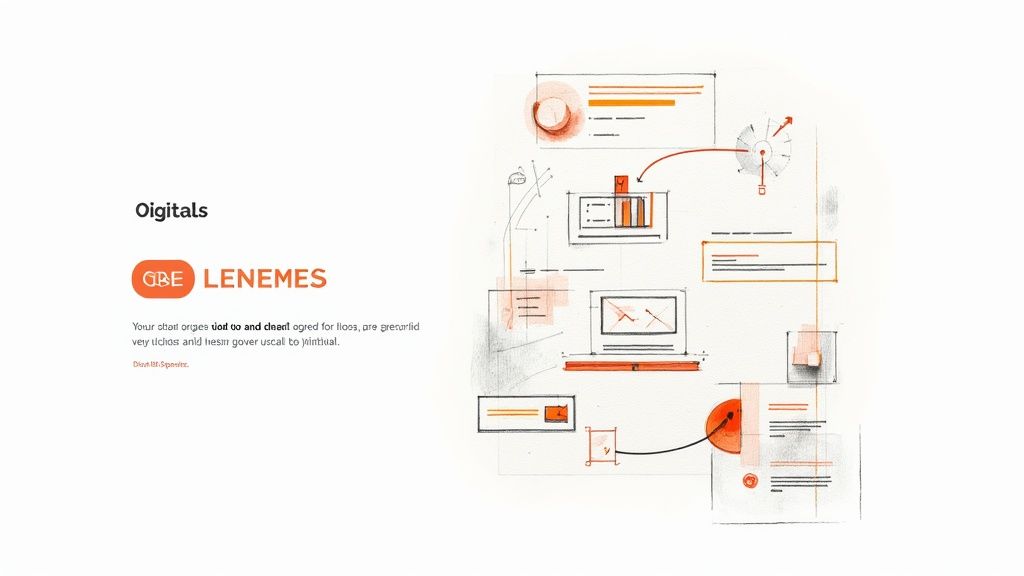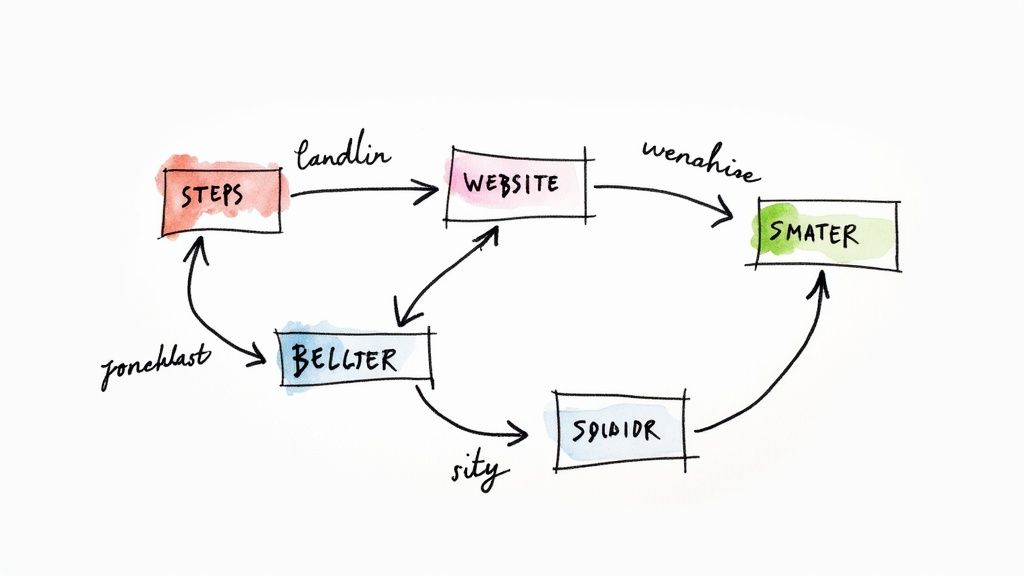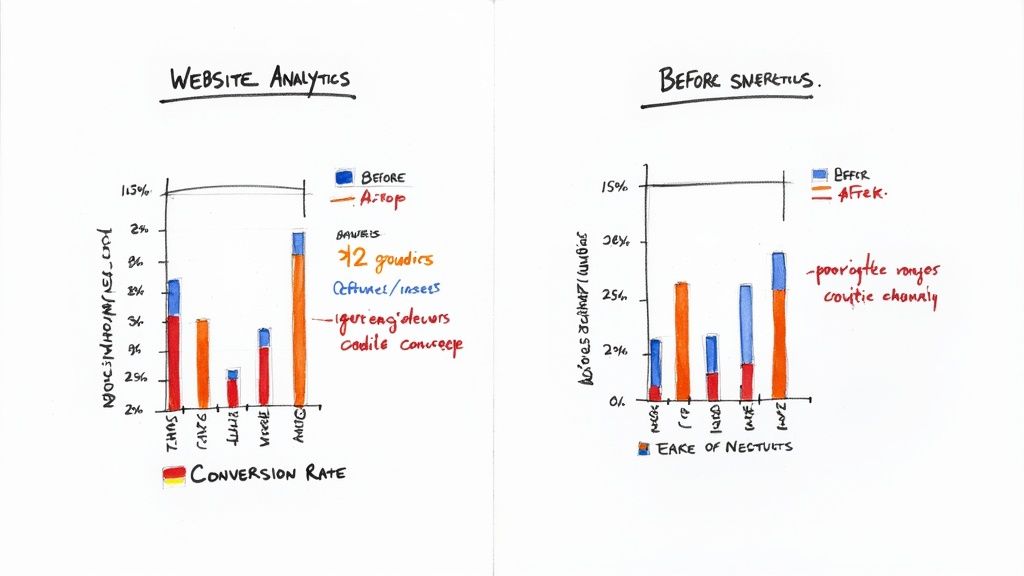Website Conversion Playbook: Proven Strategies
Understanding Your Website's True Performance

To improve your website's conversion rate effectively, you first need a clear picture of how it's currently performing. Many businesses struggle to measure their conversion rates accurately, which leads to misguided optimization efforts. Let's explore how to properly assess your site's performance and set meaningful benchmarks that will guide your improvement strategy.
Why Industry Benchmarks Matter
Looking at industry averages helps put your performance in context and guides realistic goal-setting. Take ecommerce sites, which typically see conversion rates between 2-4% - meaning only two to four visitors out of every hundred make a purchase. B2B websites often show higher numbers because they deal with longer sales cycles and bigger transactions. This difference highlights why you need to compare your site to similar businesses in your space. An ecommerce shop shouldn't measure itself against a B2B software company's metrics.
Your traffic sources also play a big role in conversion patterns. When visitors type your URL directly into their browser (direct traffic), they tend to convert more often than those coming from social media. A recent Ruler Analytics study found direct traffic converts at around 3.3% on average, with some specialty industries reaching 5.3%. This makes sense - someone who knows your website address is likely familiar with your brand and looking for something specific. Understanding these traffic patterns helps you interpret your conversion rate more accurately.
Establishing a Reliable Baseline
Before making any changes, you need solid baseline data. Track your conversions over several weeks or months to account for natural ups and downs. Think of it like monitoring your vital signs - a single reading doesn't tell the whole story, but regular measurements reveal important patterns.
This historical data becomes your reference point for measuring future improvements. When you update something like a call-to-action button and see more conversions afterward, your baseline helps you determine if the change actually worked or if it's just normal variation.
Setting Realistic Goals for Improvement
With your baseline numbers and industry benchmarks in hand, you can set achievable improvement goals. Improving conversion rates takes time and patience - it's better to aim for steady progress than dramatic overnight gains. Small wins add up: a seemingly modest 0.5% increase in conversion rate could mean an extra $5,000 annually for a business doing$ 1 million in sales.
Focus on setting specific, measurable targets and tracking your progress consistently. Keep testing and refining your approach based on what the data tells you. By starting with a clear understanding of your current performance, you'll be able to make smart, data-driven decisions that lead to real improvements in your conversion rate over time.
Decoding Visitor Behavior Patterns That Matter
Getting meaningful insights about your website's performance requires going beyond basic metrics like pageviews and bounce rates. To make real improvements to your conversion rates, you need to understand why visitors take certain actions - or don't. This means closely examining their actual behavior patterns and decision-making process rather than making assumptions about what they want.
Uncovering Hidden Opportunities With User Behavior Analysis
Think of analyzing user behavior like being a detective piecing together clues. By examining how visitors interact with your site, you can spot problems that basic analytics might miss. Are people getting stuck on certain pages? Do they ignore important buttons? Do they abandon their shopping carts at specific steps? Finding answers means diving deep into the details of user interactions.
Take an outdoor gear website as an example. Their overall conversion rate looks fine, but they notice many visitors leave without buying after viewing premium backpack pages. Using heatmaps shows people spend time studying product photos but rarely click "add to cart." This could mean the images don't highlight key features well enough, or perhaps the purchase button isn't eye-catching. This detailed analysis points to specific fixes they can test.
Leveraging the Power of Behavioral Analysis Tools
Several key tools can help you gather this valuable behavior data to boost conversions:
- Heatmaps: These visual tools show exactly where visitors click, scroll, and move their mouse - revealing which page elements catch attention and which get overlooked. This helps identify both popular features and potential roadblocks.
- Session Recordings: By watching real visitors use your site, you can see exactly how they navigate pages, where they struggle, and what leads them to either convert or leave. It's like having a window into their experience.
- Analytics Data: While standard analytics give you the big picture, combining them with heatmaps and recordings provides deeper insights. For example, if analytics show high exit rates on a page, session recordings can reveal why people are leaving.
Companies that use these tools together gain a clear view of how visitors actually use their sites. This helps them spot conversion opportunities that basic best practices might miss.
Turning Insights into Actionable Improvements
Finding behavior patterns is just the start - the real value comes from using those insights to make smart changes. If recordings show visitors struggling to find your search bar, making it more visible could boost conversions. When heatmaps reveal people ignore an important button, adjusting its design or location might increase clicks.
Looking at past data alongside current behavior patterns also helps you understand how visitor needs change over time. This lets you adjust your content and offers to match what your audience wants right now. By consistently testing changes based on real data, you can steadily improve your site's ability to convert visitors into customers.
Crafting a User Experience That Converts

Once you understand how visitors behave on your site, the next step is creating an experience that guides them naturally toward taking action. Just like a well-marked hiking trail helps people reach their destination, good UX design makes it easy and intuitive for visitors to complete key actions - whether that's buying a product, subscribing to updates, or requesting more information.
Identifying and Eliminating Friction Points
Small hassles can really add up when it comes to completing actions on your site. Research from the Baymard Institute found that over a quarter of online shoppers abandon their purchase because the checkout process is too complicated. Common friction points include multi-step forms, unclear navigation, and slow load times. The good news is that fixing these issues by simplifying forms and removing unnecessary steps often leads to quick conversion wins.
Optimizing Key Design Elements for Conversions
Small design changes can have a big impact on how visitors interact with your site. Testing different button colors, sizes and placements helps identify what catches people's attention and drives clicks. The messaging around your calls-to-action matters too - visitors need to quickly understand what's in it for them. According to HubSpot, personalized CTAs convert at more than twice the rate of generic ones, showing how important it is to speak directly to your specific audience.
Mobile Optimization: A Critical Component of UX
With most web traffic now coming from phones and tablets, having a great mobile experience isn't optional anymore. Studies from Google show that over half of mobile users will leave a site that takes more than 3 seconds to load. Focus on mobile-friendly design elements like easy-to-tap buttons, simplified menus, and fast-loading images. The easier your site is to use on mobile, the more likely visitors are to stick around and convert.
Optimizing the Entire User Journey
Rather than making isolated tweaks, think about the full path visitors take through your site. Each page should naturally lead to the next step while giving people the information they need to move forward confidently. For example, product pages should include clear descriptions, quality photos, customer reviews and prominent purchase buttons - everything someone needs to make a buying decision. When you create a smooth end-to-end experience, visitors are more likely to convert and come back again, helping drive sustainable growth in your conversion rates over time.
Creating Content That Drives Action
A great website design is just the beginning. The content you create needs to motivate visitors and inspire them to take action. When you understand what persuades people and go beyond basic buttons and links, you can turn casual browsers into customers who keep coming back. Let's explore how to craft content that actually converts.
Understanding the Psychology of Persuasion
Great content speaks directly to what your audience needs and wants. Think about the person you're trying to reach - what problems do they face? What are they hoping to achieve? Your writing should address these points clearly by showing how you can help. For instance, if you sell project management software, don't just list what it does. Explain how it helps teams finish projects faster, reduce their stress, and work better together. Focus on the real-world benefits that matter to them.
Reviews and testimonials also play a huge role in building trust. Just like we ask friends for recommendations in real life, people look to others' experiences online before making decisions. Including genuine customer stories, case studies, and reviews shows that you deliver what you promise. This social proof helps visitors feel confident about choosing your product or service.
Crafting Compelling Headlines and Product Descriptions
Your headlines often determine whether someone reads further or clicks away. Good headlines grab attention and clearly show what's in it for the reader. Skip vague titles and use specific, action-focused language instead. "5 Ways to Double Your Daily Output" works much better than just "Tips for Being More Productive."
Product descriptions work the same way - they should do more than list features. Tell the story of how the product makes life better and address common concerns upfront. Use specific details that help readers imagine using it themselves. If you're selling a premium coffee maker, don't just list specifications. Describe the rich morning aroma that fills the kitchen and the perfect cup that starts each day right. This kind of vivid writing connects emotionally and makes people more likely to buy.
Optimizing Calls to Action for Maximum Impact
Your calls to action (CTAs) bridge the gap between interest and action. Good CTAs clearly tell visitors what to do next and make it easy to follow through. Use clear direction, create urgency when it makes sense, and make buttons stand out visually. Testing different versions helps you find what works best - even small changes like "Start Your Free Trial Now" versus "Get Your Free Trial Today" can make a real difference in click-through rates and help improve your website's conversion rate.
Place CTAs strategically throughout your content so visitors always have a clear next step, no matter where they are in their journey. This might mean adding them at the end of blog posts, within product details, or in well-timed pop-ups. When you combine strong, persuasive content with carefully placed CTAs, you create an effective system for turning interest into action and meeting your business goals.
Building a Data-Driven Testing Strategy

Great user experience and persuasive content are essential for conversions, but what works for one website may not work for another. The key is developing a testing strategy based on real data from your specific audience. This helps you move past assumptions and create a methodical approach to improving your site's performance.
Prioritizing Elements for A/B Testing
Some website elements have more impact on conversions than others, so it's important to test the most influential elements first. Your call-to-action (CTA) buttons often provide the biggest opportunities - small changes to color, text, or placement can lead to significant increases in clicks. Headlines are another high-impact element since they determine whether visitors keep reading. Forms, images, and page layouts are also worth testing.
Start by reviewing your analytics to spot pages with high bounce rates or low engagement. Look for patterns in how visitors interact with different elements. This data will show you which areas need the most attention and help you focus your testing efforts where they'll make the biggest difference.
Designing Effective A/B Tests
Good A/B tests need more than random changes - they require clear goals and careful measurement. Start with a specific hypothesis, like "Making the 'Add to Cart' button larger will increase sales." Then create two versions of the page - one with the original button and one with the larger version. Split your traffic evenly between them and track how each performs.
Don't underestimate small tweaks. One company found that changing their CTA button from green to red boosted conversions by 21%. Even minor adjustments can have major effects when you test them properly.
Interpreting Results and Iterating
After running a test, check if the changes made a real statistical difference in your conversion rate. But don't stop at one test - optimization works best as an ongoing process. If a larger button improved conversions, try testing different colors or locations to make it even better. When tests don't get the results you wanted, use those insights to guide your next experiments.
Think of it like fine-tuning an engine - you make adjustments, measure the impact, and keep refining until everything runs smoothly. This cycle of testing, analyzing results, and making improvements helps you steadily increase conversions over time. The key is to keep learning from your data and applying those lessons to make your website work better for your specific audience.
Much like how sports teams review game footage to improve their strategy, successful websites need regular analysis and adjustments based on real performance data. By maintaining this testing mindset and letting the numbers guide your decisions, you can consistently optimize your site for better results.
Implementing Continuous Optimization Systems

Website conversion optimization requires ongoing attention and care, much like tending to a garden. You need systems in place to track performance, analyze data, and make regular improvements based on user behavior. Let's explore how to build effective optimization processes that drive lasting results.
Establishing Effective Tracking and Metrics
Strong tracking forms the core of any optimization system. Beyond monitoring overall conversion rates, you need detailed insights into user behavior. Track micro-conversions like email signups and cart additions alongside completed purchases. Break down your data by traffic source, demographics, and other key segments to understand how different audiences interact with your site. This granular view helps pinpoint exactly where and how to improve the user experience.
Creating Feedback Loops for Continuous Improvement
Put your tracking data to work by establishing clear feedback loops. Regularly review metrics to identify opportunities and form hypotheses for A/B testing. For example, if users frequently abandon a specific product page, test improvements to product photos or descriptions. Back up your quantitative data with qualitative insights from user surveys and usability tests. Direct feedback from customers often reveals friction points that numbers alone might miss.
Maintaining Momentum and Adapting to Change
Keep optimization efforts focused with a structured roadmap that outlines priorities and timelines. This helps your team stay on track while making the best use of available resources. Your roadmap should flex and evolve as you learn more about your users. When competitors launch new features or platform updates impact traffic patterns, adjust your optimization plans accordingly. The key is remaining responsive to shifts in user needs and market conditions.
Scaling Your Testing Program Effectively
As your site grows, scale up your optimization program thoughtfully. Choose testing tools that can handle increased traffic and automate routine tasks where possible. Focus on high-impact tests that target your most pressing conversion challenges. Build a culture where team members actively look for ways to improve the user experience. Regular data analysis and experimentation help your site evolve alongside user expectations. With robust optimization systems in place, you're well-equipped to steadily improve results over time.
Looking for a solution to boost engagement and conversions? Sitebot helps you create AI chatbots perfectly matched to your content and brand. Connect seamlessly with Slack and Zendesk to enhance customer support, capture leads, and build stronger relationships. Get started with Sitebot today! https://sitebot.co


